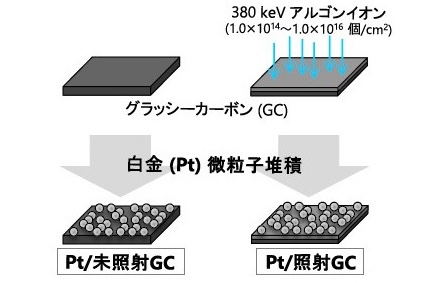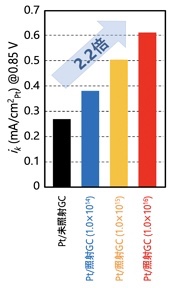

The University of Tokyo: Doubles the oxygen reduction reaction activity of fuel cell catalysts:
-Significant reduction in platinum usage-
-Advance toward 10 times the catalyst performance-
University of Tokyo
National Institutes for Quantum and Radiological Science and Technology
We have developed a “new method for retaining platinum in carbon materials irradiated with ion beams.”
Succeeded in “double the catalytic performance of polymer electrolyte fuel cell (PEFC)”.
Expansion of FCV:
In order to expand the spread of FCVs that use hydrogen, it is essential to reduce the cost of the PEFCs to be installed.
PEFC cost reduction:
The key to this is the “ORR catalyst material for PEFC oxygen poles.”
With current ORR catalysts,
The expensive Pt particles are retained in the carbon material.
A large amount of “Pt fine particles / carbon material” is used.
In reducing the amount of Pt used, improving ORR activity and durability has become a technical issue.
Ion Irradiation Research Facility (TIARA):
Using the Ion Irradiation Research Facility of the Institute of Quantitative Research
Introducing a defect structure in carbon material,
A catalyst is made by a new method of forming Pt fine particles on the surface.
Synchrotron radiation experiments and theoretical calculations:
In the elucidation of this high activation / mechanism,
By “transferring charge from Pt fine particles to carbon material”,
We found that “enhancement of interface interaction depends on the suppression of Pt oxidation”.
Defect structure introduced by ion beam:
By introducing a defect structure with an ion beam, “interfacial interaction” is strengthened.
In addition to improving ORR activity, it also suggests “the effect of suppressing deterioration of Pt fine particles associated with ORR”.
[Points of announcement]
・ Double the oxygen reduction reaction activity
For carbon materials irradiated with ion beams
With a new method of retaining platinum fine particles,
Succeeded in improving the oxygen reduction reaction activity of the fuel cell catalyst more than twice
・ Defect structure of carbon holding platinum
Improvement of oxygen reduction reaction activity,
Carbon defect structure holding platinum fine particles and
It was clarified by a new mechanism that it is caused by the interaction with platinum.
・ Significant reduction in platinum usage:
In the future, we will improve the durability and realize the actual catalyst manufacturing process.
Fuel cell costs can be reduced by significantly reducing the amount of platinum used.
http://www.t.u-tokyo.ac.jp/press/pr2022-03-31-001
Succeeded in improving the oxygen reduction reaction activity of the fuel cell catalyst more than twice-Progress toward 10 times the catalyst performance-Expected to reduce the cost of the fuel cell- (press release)
http://www.spring8.or.jp/ja/news_publications/press_release/2022/220331_2/
Токійський університет: подвоює активність реакції відновлення кисню каталізаторів паливних елементів:
– Значне скорочення використання платини-
-Розвищення продуктивності каталізатора в 10 разів
Токійський університет
Національні інститути квантової та радіологічної науки та технологій
Ми розробили «новий метод утримання платини в вуглецевих матеріалах, опромінених іонними променями».
Зумів «подвоїти каталітичні характеристики паливного елемента з полімерним електролітом (PEFC)».
Розширення FCV:
Щоб розширити поширення FCV, які використовують водень, важливо знизити вартість PEFC, які будуть встановлені.
Зниження витрат PEFC:
Ключ до цього — «матеріал каталізатора ORR для кисневих полюсів PEFC».
З існуючими каталізаторами ORR,
Дорогі частинки Pt затримуються у вуглецевому матеріалі.
Використовується велика кількість «дрібних частинок Pt/вуглецевого матеріалу».
Зменшення кількості використовуваного Pt покращення активності та довговічності ORR стало технічною проблемою.
Дослідницький центр іонного опромінення (TIARA):
Використання дослідницького комплексу іонного опромінення Інституту кількісних досліджень
Введення дефектної структури в вуглецеве матеріал,
Новим методом утворення дрібних частинок Pt на поверхні виготовляють каталізатор.
Досліди та теоретичні розрахунки синхротронного випромінювання:
У з’ясуванні цього високого механізму активації,
Шляхом «перенесення заряду від дрібних частинок Pt до вуглецевого матеріалу»,
Ми виявили, що «посилення взаємодії між поверхнями залежить від придушення окислення Pt».
Дефектна структура, внесена іонним пучком:
За допомогою введення дефектної структури іонним пучком посилюється «межфазна взаємодія».
На додаток до покращення активності ORR, він також передбачає «ефект придушення погіршення стану дрібних частинок Pt, пов’язаного з ORR».
[Пункт оголошення]
・ Подвоїти активність реакції відновлення кисню
Для вуглецевих матеріалів, опромінених іонними променями
Завдяки новому методу утримання дрібних частинок платини,
Вдалось підвищити реакційну активність каталізатора паливних елементів більш ніж вдвічі
・ Дефектна структура платини, що утримує вуглець
Поліпшення активності реакції відновлення кисню,
Вуглецева дефектна структура, що утримує дрібні частинки платини і
За новим механізмом було з’ясовано, що це викликано взаємодією з платиною.
・ Значне скорочення використання платини:
У майбутньому ми покращимо довговічність і реалізуємо фактичний процес виробництва каталізатора.
Витрати на паливні елементи можна зменшити за рахунок значного зменшення кількості використовуваної платини.
Phys. Rev. Materials 6, 035801 (2022)
– Activity enhancement of platinum oxygen-
reduction electrocatalysts using ion-beam induced defects
ABSTRACT
High activity is one of the primary requirements for the catalysts in proton exchange membrane fuel cell applications.
Platinum (Pt) is the best known catalyst, especially for oxygen reduction at the cathode;
however, further activity improvements are still required.
Previous computational studies suggested
that the catalytic activity of Pt nanoparticles could be enhanced by a Pt − carbon (C) support interaction.
We have recently found
that an enhanced electronic interaction occurs at the interface between an argon-ion ( Ar + )-irradiated glassy carbon (GC) surface and Pt nanoparticles.
Here, we report
a more than twofold increase in specific activity for the Pt nanoparticles on the Ar + -irradiated GC substrate compared to that on the nonirradiated GC substrate.
The mechanism of this activity enhancement was investigated by local structure analysis of the interface.
Ar + irradiation of the carbon support led to the formation of Pt − C bonding, thus protecting the deposited Pt nanoparticles from oxidation.
https://link.aps.org/doi/10.1103/PhysRevMaterials.6.035801